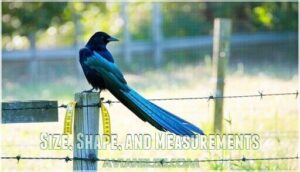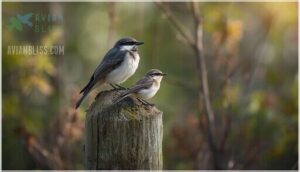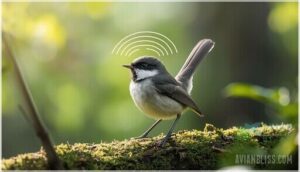This site is supported by our readers. We may earn a commission, at no cost to you, if you purchase through links.

You’ll spot its blocky head and steady tail-wagging from fenceposts and low branches, always on the lookout for insects or berries.
The eastern phoebe’s knack for adapting to changing landscapes, shifting climates, and even human-made structures makes it a standout among songbirds. Its habits, diet, and resilience tell an intriguing story.
Table Of Contents
- Key Takeaways
- Eastern Phoebe Identification
- Eastern Phoebe Habitat and Range
- Eastern Phoebe Behavior and Vocalizations
- Eastern Phoebe Diet and Feeding
- Eastern Phoebe Nesting and Reproduction
- Eastern Phoebe Conservation Status
- Frequently Asked Questions (FAQs)
- What does an eastern phoebe look like?
- What is an eastern phoebe?
- Where do eastern phoebes live?
- Where can I listen to eastern phoebe?
- Why is it called Phoebe?
- What do eastern phoebes eat?
- What is special about Eastern Phoebe?
- Are Eastern Phoebes friendly to humans?
- Do Eastern Phoebes eat wasps?
- Where do Eastern Phoebes build nests?
- Conclusion
Key Takeaways
- Eastern Phoebes thrive near human structures like bridges and buildings, using them as nesting sites instead of avoiding development like most songbirds do.
- These flycatchers catch flying insects mid-air for 90% of their diet during warm months, then switch to berries and small fruits when insects become scarce in winter.
- You can identify them by their constant tail-wagging behavior, dark blocky head, white throat, and distinctive raspy “fee-bee” call that sounds like their own name.
- Their population is growing and expanding westward because they adapt quickly to landscape changes, tolerate close human contact, and successfully reuse nesting sites year after year.
Eastern Phoebe Identification
If you’re hoping to spot an Eastern Phoebe, knowing what to look for is key. Their size, shape, and markings set them apart from other birds you might see.
Here’s what you’ll want to notice as you watch them in the field.
Size, Shape, and Measurements
Curiosity leads you to the Eastern Phoebe’s Adult Dimensions. The bird’s Size, Shape, and Measurements stand out—length ranges from 5.5 to 6.7 inches, with a wingspan of about 10.2 to 11 inches. Its Head Proportions appear blocky, and Weight Variation is seasonal.
The female is responsible for the entire incubation period. Growth Rates accelerate in young birds, making them quick to mature.
Distinctive Markings and Coloration
Spotting an Eastern Phoebe gets easier once you know its Color Pattern. The Head Contrast stands out—dark brown or blackish head meets a bright white throat. Plumage Crypticity helps it blend into bark and branches. Watch for Tail Wagging and a solid black Bill Color. Eastern Phoebes belong to the flycatcher family.
Seasonal Changes add faint yellow or buff tones, making Identifying Eastern Phoebes more rewarding.
Male, Female, and Juvenile Differences
Once you spot that crisp head-and-throat contrast, it’s time to look closer. Sexual Dimorphism in Eastern Phoebe is subtle—males are just a bit larger. Both male and female plumage shows no real variation, so don’t expect flashy differences.
Juvenile traits are easier to spot: look for faint wing bars, paler underparts, and distinct Molt Indicators.
Comparison With Similar Species
If you’re wondering how Eastern Phoebe stacks up against its lookalikes, pay attention to tail-bobbing, bill color, and wingbars. For example, Phoebe vs Pewee means spotting a plain bill and no wingbars.
Compare with Similar Species:
- Phoebe vs Least: No eye ring.
- Phoebe vs Willow: Dark head, raspy call.
- vs Empidonax: Early migration, tail-wagging.
Eastern Phoebe Habitat and Range
If you want to spot an Eastern Phoebe, it helps to know where they like to spend their time.
These birds show up in a range of places, from quiet woods to busy towns. Here’s what you can expect regarding their favorite habitats and range.
Preferred Environments and Locations
Ever noticed how Eastern Phoebes seem drawn to the edge where woods meet water? Riparian proximity is key—78% nest within 20 meters of streams. Human structures like bridges and culverts offer new ledges.
Edge habitats, with mixed trees and open ground, boost site distribution. Microhabitat features like low ledges and nearby shrubs shape their bird habitat and environment.
Breeding and Wintering Areas
When you look at Eastern Phoebe breeding grounds, you’ll notice their geographic range stretches from central Canada to the Gulf States. Habitat selection favors open woods near water, with nesting locations often under bridges or ledges.
Migration patterns of birds like these mean wintering areas overlap with breeding zones, especially in Texas and the Southeast. Climate impacts drive northward range shifts.
Adaptation to Human Presence
If you’ve noticed Eastern Phoebe nests tucked under bridges or porch eaves, that’s Urban Nesting in action. Human Habituation means these birds adapt quickly, often nesting within meters of people. Structure Expansion gives them safer spots, lowering predator risks.
Nesting Trade-offs include earlier broods and higher survival, supporting Population Stability across their expanding Habitat.
Eastern Phoebe Behavior and Vocalizations
If you’re curious about how Eastern Phoebes act and sound, you’re in the right spot. Their habits are easy to notice if you know what to look for.
Here’s what you can expect from their behavior and vocalizations.
Foraging and Feeding Techniques
Eastern Phoebe feeding habits hinge on sharp aerial foraging and perch hunting. You’ll see them dart from low branches to snatch insects mid-air—a masterclass in insect capture. Their food selection shifts with the season, mixing berries in winter. Foraging adaptations include:
- Aerial insects
- Hover-feeding
- Ground picking
- Perch hunting
- Seasonal diet changes
Flight and Perching Habits
You’ll spot these birds weaving through air with fluttering flight patterns, snapping up aerial insects. Tail-wagging isn’t just quirky; it’s predator awareness in action.
Their perch selection is practical—fenceposts, branches, or even deer backs when food’s scarce. Wind influence shapes their feeding behavior, with longer perch times and fewer flights when gusts pick up.
Song Patterns and Calls
Ever heard a bird say its own name? That’s the “fee-bee” song structure of Eastern Phoebe vocalizations—sharp, buzzy, and instantly recognizable. Call variation isn’t just noise; it signals alarm, territory, or breeding songs. Neural mechanisms shape these vocalizations, letting each bird keep its own call and song signature.
Behavioral roles shift with season, pairing, and predator threats.
Eastern Phoebe Diet and Feeding
You might be curious about what Eastern Phoebes eat and how they find their food. Their feeding habits shift with the seasons and available resources.
Here’s a look at what makes up their diet and the ways they forage.
Primary Insect Prey
When you look at the Eastern Phoebe diet and feeding, insect consumption is front and center. As an insectivore, it targets diverse Insect Orders—bees, flies, beetles, and moths.
Prey capture is swift, with foraging strategies focused on aerial insects. Arthropod diversity shapes its dietary habits, making insect prey the backbone of its diet composition.
Seasonal Fruit and Berry Consumption
When insect numbers drop, your Eastern Phoebe’s diet pivots toward berries and fruit. Fruit availability shapes dietary shifts, especially during migration patterns. You’ll notice berry selection follows native plants, like mulberries and elderberries. Here’s what matters:
- Seasonal berry consumption rises
- Food sources shift in cooler months
- Nutritional value aids migration
- Berry selection tracks fruiting cycles
Foraging Strategies
When berries run low, your Eastern Phoebe leans into Perch Hunting. You’ll see it scan from low branches, dart out for quick Insect Capture, and return to the same spot. This Feeding Behavior keeps energy use low while boosting prey detection.
Here’s a peek at their Foraging Tactics:
| Foraging Tactic | Success Rate |
|---|---|
| Perch Hunting | 88% |
| Sally Flights | 65–75% |
| Prey Detection | High |
| Feeding Frequency | 30–90/hr |
Eastern Phoebe Nesting and Reproduction
Eastern Phoebes have some interesting habits regarding nesting and raising their young. If you’re curious about how these birds choose spots, care for eggs, and use nearby buildings, you’re in the right place. Here’s what you can expect from their nesting and reproduction.
Nest Building Sites and Materials
You might be surprised by how adaptable Eastern Phoebe nesting behavior is. Nest Site Selection favors sheltered spots—think cave nests, bridge usage, or ledges near water.
The nest base uses mud composition, layered with green moss and lined with grasses and animal hair. All nesting materials are gathered locally, making Eastern Phoebe nesting and breeding a true study in resourcefulness.
Egg Characteristics and Brood Size
Every Eastern Phoebe nest holds a clutch of three to eight eggs, usually white with subtle reddish-brown speckles—classic egg coloration for this species. You’ll notice clutch variation, especially between early and late broods.
The female undertakes a 14–17 day incubation period. Fledging success often hinges on parasitic influence, with cowbird eggs sometimes lowering the number of young that survive.
Parental Care and Fledgling Development
While you watch Eastern Phoebe parents at work, you’ll notice their Parental Duties are shared. Feeding Rates climb as Nestlings grow, peaking before Independence. Young often stay near the Nest up to two weeks Post-Fledging.
You’ll see:
- Both parents feed and clean the Nest
- Fledgling Growth is steady
- Broods may receive care for 23 days
Use of Human-Made Structures
Across neighborhoods and farmyards, Eastern Phoebes excel at nest site selection, often choosing bridges, culverts, and buildings. Urban nesting success is high, thanks to platform nest programs and adaptable building material impact.
Bridge nest reuse is common, with old nests often relined for new eggs. This shift expands Eastern Phoebe habitat and range, supporting stable populations and reliable nesting.
Eastern Phoebe Conservation Status
If you’re curious about how Eastern Phoebes are faring in the wild, you’re in the right spot. There are a few key things that shape their conservation status.
Let’s take a closer look at what matters most for their future.
Population Trends and Threats
Did you know the Conservation Status of the Phoebe is “Least Concern” on the IUCN Red List? Population trends show growth, but threats remain. Climate change shifts their range and timing. Habitat loss, pesticide exposure, and brood parasitism all chip away at stability.
Conservation of birds like the Eastern Phoebe means watching these risks closely, even as numbers rise.
Legal Protections
Did you know Eastern Phoebe’s safety isn’t just luck—it’s law? Here’s how:
- MBTA Penalties protect them in the U.S.
- Canadian Protections mirror these rules.
- Permitted Activities require strict federal permits.
- International Treaties help guard migration routes.
- Nesting Substrates near construction need review.
Conservation Status of the Phoebe: “Least Concern” (IUCN Red List).
Impacts of Climate and Human Activity
Wondering how climate and people shape Eastern Phoebe’s future? Habitat fragmentation and pesticide exposure squeeze their food supply, while insect decline and extreme weather challenge nesting success.
Urban adaptation helps them survive, but migration patterns shift with warming springs.
The Conservation Status of the Phoebe stays “Least Concern,” yet changes in habitat and range demand close attention.
Brood Parasitism and Other Challenges
You’ve seen how climate shifts test Eastern Phoebe survival. Now, brood parasitism adds more twists. Brown-headed cowbird egg ejection drops fledgling success, while host defense intensity wanes near people. Nest predators—crows, snakes, raccoons—push clutch failure rates higher. Here’s what they face:
- Cowbird egg ejection
- Declining fledgling success
- Diverse nest predator types
Frequently Asked Questions (FAQs)
What does an eastern phoebe look like?
Imagine this: you’re standing by a stream when a small bird lands on a nearby branch and immediately starts pumping its tail. That’s your first clue. The Eastern Phoebe is a medium-sized songbird with dull gray-brown body feathers on top and a clean white belly. Its head is dark, often the darkest part of its plumage, and it lacks eye rings or wing bars that other flycatchers have.
The Eastern Phoebe is a gray-brown songbird with a dark head, white belly, and distinctive tail-pumping behavior that sets it apart from similar flycatchers
You’ll notice its stocky, plump build and that distinctive tail-wagging behavior. Both sexes look similar—males slightly darker—while juveniles show duller, mottled feathers. The bird measures about 7 to 5 inches long with a wingspan around 10 to 11 inches. In fall, fresh plumage may show faint yellow on the belly, but overall, this is a plainly dressed bird.
Its short, thin bill is built for snatching insects mid-air, and that constantly flicking tail is the best field mark you’ll see.
What is an eastern phoebe?
The Eastern Phoebe is a small flycatcher species measuring about 5 to 7 inches long. You’ll recognize this bird by its gray-brown plumage, distinctive tail-wagging behavior, and raspy “fee-bee” song that echoes through woodlands and suburban areas.
Where do eastern phoebes live?
You’ll find these birds across a broad swath of the continent. Eastern Phoebe habitat and range stretches from central Canada down through the eastern United States, reaching Georgia and Texas. Their range expansion continues westward into Montana and Wyoming, while winter habitats include the Gulf States and Mexico.
Migration routes cover roughly 2,000 miles, with elevation preferences favoring lower riparian zones. Habitat diversity includes woodland edges, streams, and human structures like bridges—showing considerable adaptability across their expanding Range Map.
Where can I listen to eastern phoebe?
You can hear their raspy “fee-bee” song near water sources, bridges, and woodland edges, especially at dawn during spring and summer. Urban listening at eaves and building ledges works well.
Migration routes and wintering grounds offer seasonal timing opportunities for hearing their distinctive bird calls and vocalizations.
Why is it called Phoebe?
A bird’s name can come straight from its own voice—that’s the paradox of the Eastern Phoebe, whose call characteristics sound like “fee-bee.” This onomatopoeia shaped Audubon’s naming choice in 1804, making it a flycatcher with historical records rooted in its distinctive vocalizations and natural bird call identity.
What do eastern phoebes eat?
You’ll spot these birds catching flying insects mid-air during warmer months, which make up over 90% of their diet. Insects like wasps, beetles, grasshoppers, and flies are their primary prey.
When winter arrives, they adapt by eating small fruits and berries like sumac and elderberries.
What is special about Eastern Phoebe?
You’ll recognize this bird by its signature tail-wagging behavior and raspy “fee-bee” song.
Eastern Phoebes nest on human structures like bridges and buildings, allowing them to thrive near people while controlling insect pests effectively.
Are Eastern Phoebes friendly to humans?
You might notice these birds don’t flee when you approach—their urban adaptation and human habituation mean Eastern Phoebes tolerate close nest proximity and foraging interactions with remarkably calm fear responses and bird behavior around people.
Do Eastern Phoebes eat wasps?
Yes, Eastern Phoebes eat wasps regularly. Wasp consumption makes up about 26% of their annual diet, especially increasing in late summer. You’ll see them catch these flying insects mid-air using their flycatcher hunting style from perches.
Where do Eastern Phoebes build nests?
You’ll find their nests tucked under bridges, building eaves, rocky ledges, and cliff faces—usually less than 15 feet high.
Eastern Phoebes show strong nest site fidelity, often returning to the same sheltered spot year after year, building mud-based cups lined with moss near water sources.
Conclusion
Think of the eastern phoebe as a bridge between wild and built worlds. While most songbirds retreat from human expansion, this flycatcher flies toward it, turning culverts and porches into nurseries.
You’ve seen how its tail-wagging, nest-site choices, and year-round foraging make it thrive where others struggle. That adaptability isn’t just survival—it’s proof that some species can rewrite the rules when landscapes shift, making them neighbors worth watching.
- https://www.allaboutbirds.org/guide/Eastern_Phoebe/id
- https://animaldiversity.org/accounts/Sayornis_phoebe/
- https://dnr.illinois.gov/education/wildaboutpages/wildaboutbirds/wildaboutbirdsflycatchers/wabeasternphoebe.html
- https://www.audubon.org/field-guide/bird/eastern-phoebe
- https://www.tn.gov/twra/wildlife/birds/eastern-phoebe.html












